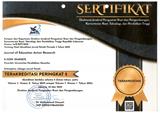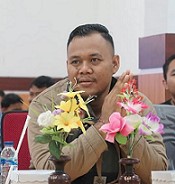The Sentiments of Students and Teachers on Modular Distance Learning Amid the Health Crisis
DOI:
https://doi.org/10.23887/ijerr.v6i2.61478Keywords:
Elementary School, Modular Learning, Learning Experiences, Pandemic, Remote AreasAbstract
Due to the COVID-19 pandemic, schools, particularly in rural areas, employed Modular Distance Learning (MDL) to ensure educational continuity. Modular distance learning is the current learning modality of primary education, where parents serve as parent-teachers to their children. This study seeks to evaluate the experiences of students and teachers of Elementary School, on modular distance learning during the pandemic. This study used the qualitative method of interviewing nine students and six teachers to learn about their MDL experiences. Data process involves combining related concepts and themes to produce a more structured and organized picture of the data. MDL strengthens family bonding, promotes independent learning, and economizes money and time. However, it is an additional workload for working parents; there needs to be more teacher-student interaction, preventing pupils from socializing and gadget distractions. The article revealed that MDL has positive and negative experiences for teachers and students. Therefore, the impact may vary depending on individual circumstances and adaptability. The study suggests that suitable strategies should address any challenges during implementation and evaluation. Furthermore, teachers must undergo training related to MDL to address existing problems in delivering their lessons.
References
Agaton, C. B., & Cueto, L. J. (2021). Learning at Home: Parents’ Lived Experiences on Distance Learning during COVID-19 Pandemic in the Philippines. International Journal of Evaluation and Research in Education, 10(3), 901–911. https://eric.ed.gov/?id=EJ1313094.
Alhalafawy, W. S., & Zaki. (2019). MZTThe Effect of Mobile Digital Content Applications Based on Gamification in the Development of Psychological Well-Being. International Journal of Interactive Mobile Technologies, 13(8). https://doi.org/10.3991/ijim.v13i08.10725.
Aprilliyah. (2014). Pengembangan Media Pembelajaran Modul Interaktif Pada Materi Jurnal Khusus Kelas X Akuntansi di SMK Negeri Mojoagung. Jurnal Khusus, 2(2), 1–7. https://jurnalmahasiswa.unesa.ac.id/index.php/35/article/view/9412.
Bagde, P., Bagde, L. P., & Raisoni, G. H. (2021). Information and communication technology (ICT) enabled higher education: Current trends and challenges. Elementary Education Online, 20(1), 2528–2537. https://search.ebscohost.com/login.aspx?direct=true&profile=ehost&scope=site&authtype=crawler&jrnl=13053515&AN=150153932&h=8WOgUV0mewFRc1QB0KgVmqL6VQ65d9FgsxYpR8K72RFTSEMSRiNj5O9meMcXuwriUovfuaM31ohDsRRcu3Y79w%3D%3D&crl=c.
Bautista, A. B., & Masaluñga, R. K. (2020). Distance Learning in the Philippines: The Emergence of a New Mode of Education in the Time of COVID-19 Pandemic. International Journal of Academic Research in Business and Social Sciences, 10(8), 746–759. https://papers.ssrn.com/sol3/papers.cfm?abstract_id=3636438.
Bystrova, T. (2020). Infographics As a Tool for Improving Effectiveness of Education. KnE Social Sciences, 2020, 152–158. https://doi.org/10.18502/kss.v4i13.7710.
Carrillo, L. M. (2020). The Challenges of Online Learning in the Philippines During COVID-19. Journal of Educational and Social Research, 10(4), 225–233. https://doi.org/10.36941/jesr-2020-0044.
Casinillo, E. L., Lina Jr, E. R., Casinillo, L. F., Batidor, P. G., & Lebante, M. R. (2022). Econometric Evidence on Statistical Anxiety of Engineering Students during the New Normal Setup. Philippine Social Science Journal, 5(4), 9–17. https://doi.org/10.52006/main.v5i4.564.
Casinillo, L. F. (2022). Modeling determinants of challenge in learning statistics in time of the COVID-19 pandemic. Philippine Social Science Journal, 5(3), 131–139. https://doi.org/10.52006/main.v5i3.536.
Casinillo, L. F., Casinillo, E. L., Valenzona, J. V, Almonite, M. R. C., & Valenzona, D. L. (2022). How challenging it is to learn mathematics online. Philippine Social Science Journal, 5(1), 80–89. https://doi.org/10.52006/main.v5i1.447.
Cleofas, J. V. (2021). Life interruptions, learnings and hopes among Filipino college students during COVID-19 pandemic. Journal of Loss and Trauma, 26(6), 552–560. https://doi.org/10.1080/15325024.2020.1846443.
Fathoni, A., Mustadi, A., Kurniawati, W., & Artikel, R. (2021). Persepsi Mahasiswa Pgsd pada Pembelajaran Daring di Masa Pandemi Covid-19. Kwangsan, 9(1), 347038. https://doi.org/10.31800/JTP.KW.V9N1.P107--123.
Fearnley, M. R., & Amora, J. T. (2020). Learning Management System Adoption in Higher Education Using the Extended Technology Acceptance Model. IAFOR Journal of Education, 8(2), 89–106. https://doi.org/10.22492/ije.8.2.05.
Geminiano, L. A. (2021). Modular Distance Learning in the Philippines: Implications and Challenges During the COVID-19 Pandemic. Asian Journal of Distance Education, 16(1), 43–57. http://www.asianjde.com/ojs/index.php/AsianJDE/article/view/462.
Guinto, R. L., Estacio, E. V, & Vera, M. (2020). Philippine education in the time of COVID-19: Issues and recommendations. Asia Pacific Journal of Education, 40(3), 285–302. https://doi.org/10.1080/02188791.2020.1781123.
Guzman, J. A. (2020). Modular Distance Learning: A New Normal in Philippine Education. Journal of Education and Learning, 9(4), 321–329. https://doi.org/10.5539/jel.v9n4p321.
Halili, S. H. (2020). Digital Divide: Challenges of Online Learning in the Philippines. Journal of Science and Technology Policy Management, 11(3), 372–379. https://doi.org/10.1108/JSTPM-06-2020-0125.
Irawaty, E., Widjaja, E. M., & Sanjaya, J. (2021). Peningkatan Kualitas Belajar Dalam Menghadapi Pembelajaran Daring. Prosiding SENAPENMAS, 985. https://doi.org/10.24912/psenapenmas.v0i0.15131.
Jamal, S. (2020). Analisis Kesiapan Pembelajaran E-Learning Saat Pandemi Covid-19 Di Smk Negeri 1 Tambelangan. Jurnal Nalar Pendidikan, 8(1), 16. https://doi.org/10.26858/jnp.v8i1.13561.
Joven, E. P., Joven, B. A., & Castro, M. S. (2021). Modular Distance Learning amid COVID-19 Pandemic: Challenges and Prospects. International Journal of Innovative Research in Education, 8(2), 16–26. https://search.proquest.com/openview/147386d836d442fa76b9cb2853274f83/1?pq-origsite=gscholar&cbl=18750&diss=y.
Kang, J., & Im, T. (2020). Distance Learning in Higher Education during COVID-19: The Effects of Digital Learning Innovation on Student Learning Outcomes. Journal of Educational Technology Development and Exchange, 13(1), 1–14. https://scholarworks.sjsu.edu/faculty_rsca/2460/.
Lase, D., Zega, T. G. C., & Daeli, D. O. (2021). Parents’ Perceptions of Distance Learning during COVID-19 Pandemic in Rural Indonesia. SSRN Electronic Journal, June 2021. https://doi.org/10.2139/ssrn.3890610.
Maria Josephine Arokia Marie, S. (2021). Improved pedagogical practices strengthens the performance of student teachers by a blended learning approach. Social Sciences & Humanities Open, 4(1), 100199. https://doi.org/10.1016/j.ssaho.2021.100199.
Mason, M. (2010). Sample size and saturation in PhD studies using qualitative interviews. Forum Qualitative Sozialforschung/Forum: Qualitative Social Research, 11(3). http://www.qualitative-research.net/index.php/fqs/article/view/1428.
Morrow, R., Rodriguez, A., & King, N. (2015). Colaizzi’s descriptive phenomenological method. The Psychologist, 28(8), 643–644. http://eprints.hud.ac.uk/id/eprint/26984/1/Morrow_et_al.pdf.
Nieto-Escamez, F. A., & Roldán-Tapia, M. D. (2021). Gamification as Online Teaching Strategy During COVID-19: A Mini-Review. Frontiers in Psychology, 12(May), 1–9. https://doi.org/10.3389/fpsyg.2021.648552.
Rotas, E., & Cahapay, M. (2020). Difficulties in Remote Learning: Voices of Philippine University Students in the Wake of COVID-19 Crisis. Asian Journal of Distance Education, 15(2), 147–158. https://doi.org/10.5281/zenodo.4299835.
Salazar, J. J. (2020). Learning in the Time of COVID-19: Philippine Education in Crisis. Philippine Journal of Public Administration, 64(2), 149–168. https://doi.org/10.13185/pjpa.2020.64.2.149.
Salis Hijriyani, Y., & Astuti, R. (2020). Penggunaan Gadget pada Anak Usia Dini dalam Menghadapi Era Revolusi Industri 4.0. ThufuLA: Jurnal Inovasi Pendidikan Guru Raudhatul Athfal, 8(1), 015. https://doi.org/10.21043/thufula.v8i1.6636.
Sanchez, L. P., Cruz, M. R. C., Morales, E. R. A., & Bautista, M. A. (2021). Modular distance learning in the Philippines during COVID-19 pandemic: Student and teacher perspective. The Online Journal of Distance Education and E- Learning, 9(1), 97–108. https://doi.org/10.17706/tojdel.2021.9.1.822.
Sevilla, C. G., Dator, A. S., & Vera, A. R. (2020). A New Normal in Philippine Education: The Modular Distance Learning. Journal of Environmental Science and Management, 23(2), 76–80. https://doi.org/10.35471/jesm.2020.23.2.76-.
Singh., P., & Prasad Singh, M. (2021). The Role of Teachers in Motivating Students to Learn. LEARN An International Journal of Educational Technology Techno, 11(1), 2021. https://doi.org/10.30954/2231-4105.01.2021.6.
Slovaček, K. A., & Čosić, G. (2020). The Role of Parents during the COVID19 Pandemic in Croatia. Studies in Educational Management, 8(8), 9–17. https://doi.org/10.32038/sem.2020.08.02.
Taufan, M. Y. (2022). Professional Development of Teachers, Competencies, Educational Facilities and Infrastructure on Teacher Performance and Learning Achievement of High School Students in Makassar City. Golden Ratio of Social Science and Education, 2(1), 24–38. https://doi.org/10.52970/grsse.v2i1.168.
Toribio, J. V. T. (2021). Distance Learning in the Time of COVID-19: Philippine Context. International Journal of Advanced Research in Engineering and Technology, 12(1), 166–174. https://dergipark.org.tr/en/pub/ueader/issue/71159/1064312.
Valenzona, J. V, Casinillo, L. F., & Casinillo, E. L. (2022). Modeling students’ innovativeness and its factors in learning mathematics amidst COVID-19 pandemic. The Palawan Scientist, 14(1), 43–50. https://www.palawanscientist.org/tps/wp-content/uploads/2022/04/5_Valenzona-et-al.pdf.
Vistan, R. L. (2021). Challenges encountered by teachers in modular distance learning: A phenomenological study. Journal of Learning and Teaching in Digital Age, 6(1), 1–12. https://doi.org/10.21432/T2RX10.
Yunita Anindya, E. F., Suneki, S., & Purnamasari, V. (2019). Analisis Gerakan Literasi Sekolah Pada Pembelajaran Tematik. Jurnal Ilmiah Sekolah Dasar, 3(2), 238. https://doi.org/10.23887/jisd.v3i2.18053.
Downloads
Published
How to Cite
Issue
Section
License
Copyright (c) 2023 Mariel De Aquino, Argilyn Balingit, Airen Bontog, Pamela Jane Fortugaliza, Melbert Hungo, Leomarich F Casinillo

This work is licensed under a Creative Commons Attribution-ShareAlike 4.0 International License.
Authors who publish with the Indonesian Journal of Educational Research and Review (IJERR) agree to the following terms:
- Authors retain copyright and grant the journal the right of first publication with the work simultaneously licensed under a Creative Commons Attribution License (CC BY-SA 4.0) that allows others to share the work with an acknowledgment of the work's authorship and initial publication in this journal.
- Authors are able to enter into separate, additional contractual arrangements for the non-exclusive distribution of the journal's published version of the work (e.g., post it to an institutional repository or publish it in a book), with an acknowledgment of its initial publication in this journal.
- Authors are permitted and encouraged to post their work online (e.g., in institutional repositories or on their website) prior to and during the submission process, as it can lead to productive exchanges, as well as earlier and greater citation of published work. (See The Effect of Open Access)












